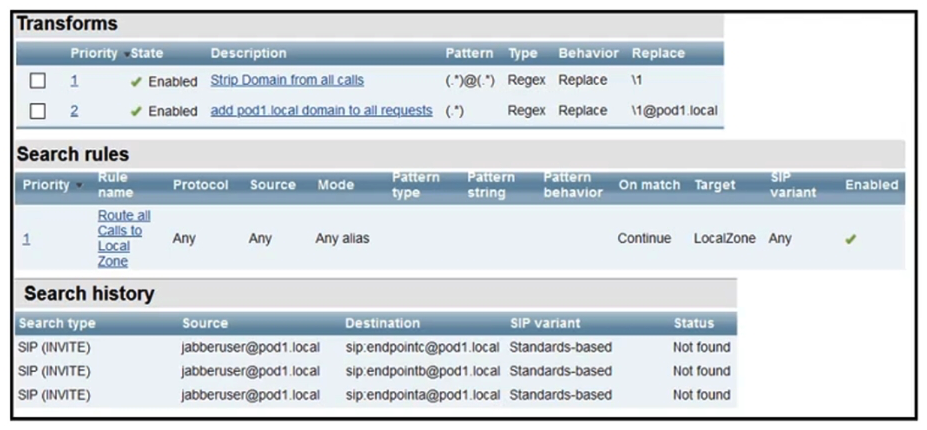Multiple Choice
 Refer to the exhibit. Calls to locally registered endpoints are failing. At present, there are two endpoints registered locally to this Expressway. An H.323 endpoint with an alias of "EndpointA" is registered, and a SIP endpoint with an alias of "EndpointB@pod1.local" is also registered. How is this issue resolved?
Refer to the exhibit. Calls to locally registered endpoints are failing. At present, there are two endpoints registered locally to this Expressway. An H.323 endpoint with an alias of "EndpointA" is registered, and a SIP endpoint with an alias of "EndpointB@pod1.local" is also registered. How is this issue resolved?
A) The dialplan must be redesigned to use the transforms to convert the alias into SIP URI format and then use separate search rules for each format that needs to be dialed within the local zone.
B) The calls are failing because there are insufficient licenses. Additional licenses must be installed for the Expressway to route these calls.
C) The current search rule does not match the call, so the search rule must be modified to include a SIP Variant of "Standards-Based".
D) Calling parties are placing calls with the wrong domain. End-users must be instructed not to use the pod1.local domain as that is owned by the local system. Calls to any other domain would work.
Correct Answer:

Verified
Correct Answer:
Verified
Q8: Between which two DTMF relay methods does
Q9: When a Cisco Webex Video Mesh Node
Q10: Which describes what could done on the
Q11: What it is the purpose of using
Q12: In a Mobile and Remote Access deployment,
Q14: <img src="https://d2lvgg3v3hfg70.cloudfront.net/C1178/.jpg" alt=" Refer to the
Q15: Which two statements about Mobile and Remote
Q16: When configuring a Cisco Expressway solution and
Q17: What allows endpoints behind a NAT to
Q18: What is a key configuration requirement for